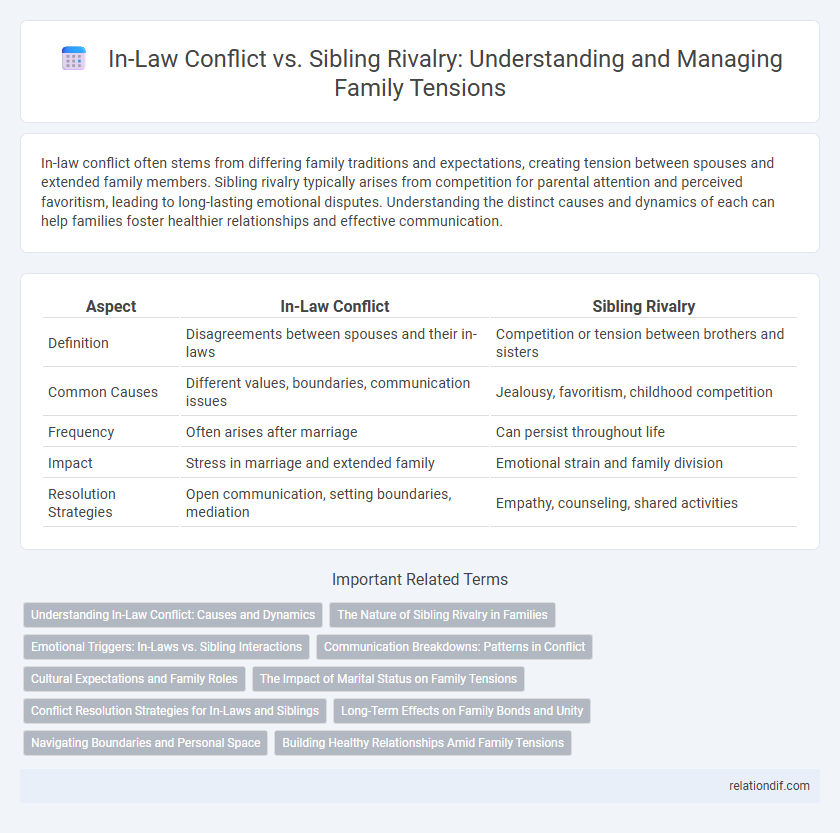In-law conflict often stems from differing family traditions and expectations, creating tension between spouses and extended family members. Sibling rivalry typically arises from competition for parental attention and perceived favoritism, leading to long-lasting emotional disputes. Understanding the distinct causes and dynamics of each can help families foster healthier relationships and effective communication.
Table of Comparison
| Aspect | In-Law Conflict | Sibling Rivalry |
|---|---|---|
| Definition | Disagreements between spouses and their in-laws | Competition or tension between brothers and sisters |
| Common Causes | Different values, boundaries, communication issues | Jealousy, favoritism, childhood competition |
| Frequency | Often arises after marriage | Can persist throughout life |
| Impact | Stress in marriage and extended family | Emotional strain and family division |
| Resolution Strategies | Open communication, setting boundaries, mediation | Empathy, counseling, shared activities |
Understanding In-Law Conflict: Causes and Dynamics
In-law conflict often arises from differing family values, communication styles, and expectations about roles and boundaries, creating unique tension compared to sibling rivalry. Unlike sibling disputes rooted in shared history and competition for parental attention, in-law conflicts stem from integrating new family dynamics and negotiating influence. Effective resolution requires acknowledging these distinct causes and fostering mutual respect between in-laws to build cohesive relationships.
The Nature of Sibling Rivalry in Families
Sibling rivalry in families often stems from competition for parental attention, resources, and approval, creating a persistent emotional undercurrent that shapes relationships over time. Unlike in-law conflicts, which typically arise from differing family cultures and external obligations, sibling rivalry is deeply rooted in shared history and developmental dynamics. Understanding the psychological and social mechanisms behind sibling rivalry helps mitigate its negative impact on family cohesion and individual well-being.
Emotional Triggers: In-Laws vs. Sibling Interactions
In-law conflicts often stem from differing family traditions, boundary misunderstandings, and loyalty tensions, while sibling rivalry is typically fueled by competition for parental attention, unresolved childhood grievances, and perceived favoritism. Emotional triggers in in-law disputes frequently involve feelings of exclusion or disrespect within the extended family network. Sibling interactions trigger deep-seated emotions linked to shared history and identity, making their conflicts more emotionally intense and long-lasting.
Communication Breakdowns: Patterns in Conflict
In-law conflicts often stem from communication breakdowns rooted in differing expectations and boundary misunderstandings, causing persistent tension between family units. Sibling rivalry typically features long-standing patterns of competition and unresolved grievances that hinder direct and open dialogue. Effective resolution requires recognizing these unique communication patterns and fostering empathetic listening to bridge gaps and reduce hostility.
Cultural Expectations and Family Roles
In-law conflict often stems from clashing cultural expectations and differing perceptions of family roles, especially in multicultural households where traditions regarding respect and hierarchy vary significantly. Sibling rivalry typically revolves around competition for parental attention and inheritance, influenced by long-standing family dynamics and birth order. Understanding the distinct cultural frameworks shaping in-law tensions versus sibling disputes is essential for addressing underlying issues effectively.
The Impact of Marital Status on Family Tensions
Marital status significantly influences family dynamics, often intensifying in-law conflicts compared to sibling rivalry due to the merging of different family systems and expectations. In-law tensions frequently stem from role ambiguity and loyalty conflicts between spouses and their birth families, while sibling rivalry primarily arises from competition for parental attention and resources. Understanding these distinctions helps in developing targeted conflict resolution strategies tailored to the unique challenges posed by marital alliances and sibling relationships.
Conflict Resolution Strategies for In-Laws and Siblings
Effective conflict resolution strategies for in-laws and siblings include open communication, setting clear boundaries, and fostering mutual respect to address underlying issues. Employing active listening techniques helps parties understand different perspectives while mediation by a neutral family member or counselor can facilitate constructive dialogue. Prioritizing empathy and collaborative problem-solving reduces tension and strengthens family bonds amidst disagreements.
Long-Term Effects on Family Bonds and Unity
In-law conflicts often create persistent barriers between extended family members, undermining long-term unity by fostering resentment and mistrust. Sibling rivalry, while typically rooted in childhood, can also erode family bonds if unresolved, leading to ongoing competition and emotional distance. Both types of conflicts impact the family's cohesion, but in-law disputes tend to affect a broader network, complicating reconciliation efforts.
Navigating Boundaries and Personal Space
Navigating boundaries and personal space is essential in managing in-law conflict versus sibling rivalry, as in-law disputes often arise from differing expectations and involvement in family matters. Establishing clear communication and respecting individual autonomy can prevent tensions between in-laws who may feel excluded or overstepped. Sibling rivalries, shaped by shared history and competition, require setting limits on intrusion and fostering mutual respect to maintain healthy relationships.
Building Healthy Relationships Amid Family Tensions
Navigating in-law conflict requires setting clear boundaries and fostering open communication to differentiate it from sibling rivalry, which often revolves around competition and shared history. Prioritizing empathy and mutual respect helps de-escalate tensions and promotes understanding among family members. Establishing regular family meetings encourages dialogue, enabling all parties to express concerns and work collaboratively towards resolution.
in-law conflict vs sibling rivalry Infographic

 relationdif.com
relationdif.com